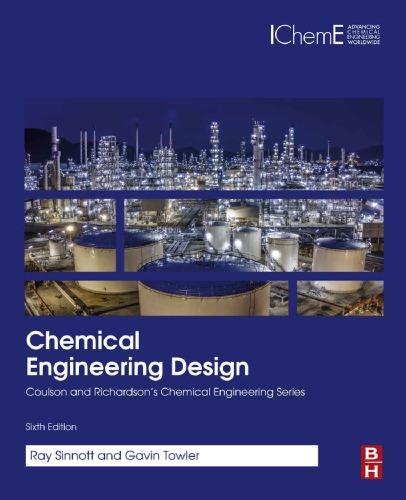INTRODUCTIONTODESIGN 1
CHAPTERCONTENTS
1.1Introduction
1.2NatureofDesign
1.3TheAnatomyofaChemicalManufacturingProcess
1.4TheOrganizationofaChemicalEngineeringProject
1.5ProjectDocumentation
1.6CodesandStandards
1.7DesignFactors(DesignMargins)
1.8SystemsofUnits
1.9Optimization
1.10References
1.11Nomenclature
1.12Problems
KEYLEARNINGOBJECTIVES
• Howdesignprojectsarecarriedoutanddocumentedinindustry
• Whyengineersinindustryusecodesandstandardsandbuildmarginsintotheirdesigns
• Howtoimproveadesignusingoptimizationmethods
• Whyexperienceddesignengineersveryrarelyuserigorousoptimizationmethodsinindustrialpractice
1.1 INTRODUCTION
Thischapterisanintroductiontothenatureandmethodologyofthedesignprocess,anditsapplication tothedesignofchemicalmanufacturingprocesses.
1.2 NATUREOFDESIGN
Thissectionisageneraldiscussionofthedesignprocess.Thesubjectofthisbookischemical engineeringdesign,butthemethodologydescribedinthissectionappliesequallytootherbranches ofengineering.
ChemicalEngineeringDesign. https://doi.org/10.1016/B978-0-08-102599-4.00001-1 # 2020ElsevierLtd.Allrightsreserved.
Chemicalengineeringhasconsistentlybeenoneofthehighest-paidengineeringprofessions.There isademandforchemicalengineersinmanysectorsofindustry,includingthetraditionalprocessing industries:chemicals,polymers,fuels,foods,pharmaceuticalsandpaper,aswellasothersectorssuch aselectronicmaterialsanddevices,consumerproducts,miningandmetalsextraction,biomedical implantsandpowergeneration.
Thereasonthatcompaniesinsuchadiverserangeofindustriesvaluechemicalengineerssohighly isthefollowing:
Startingfromavaguelydefinedproblemstatementsuchasacustomerneedorasetofexperimental results,chemicalengineerscandevelopanunderstandingoftheimportantunderlyingphysical sciencerelevanttotheproblemandusethisunderstandingtocreateaplanofactionandsetofdetailed specifications,whichifimplemented,willleadtoapredictedfinancialoutcome
Thecreationofplansandspecificationsandthepredictionofthefinancialoutcomeiftheplanswere implementedistheactivityofchemicalengineeringdesign.
Designisacreativeactivity,andassuchcanbeoneofthemostrewardingandsatisfyingactivities undertakenbyanengineer.Thedesigndoesnotexistatthestartoftheproject.Thedesignerbeginswith aspecificobjectiveorcustomerneedinmind,andbydevelopingandevaluatingpossibledesigns, arrivesatthebestwayofachievingthatobjective;beitabetterchair,anewbridge,orforthechemical engineer,anewchemicalproductorproductionprocess.
Whenconsideringpossiblewaysofachievingtheobjective,thedesignerwillbeconstrainedby manyfactors,whichwillnarro wdownthenumberofpossiblede signs.Therewillrarelybejust onepossiblesolutiontotheproblem,justonede sign.Severalalterna tivewaysofmeetingthe objectivewillnormallybepossible,evensevera lbestdesigns,dependingonthenatureofthe constraints.
Theseconstraintsonthepossiblesolutionstoadesignproblemariseinmanyways.Some constraintswillbefixedandinvariable,suchasthosethatarisefromphysicallaws,government regulations,andstandards.Otherswillbelessrigid,andcanberelaxedbythedesigneraspartof thegeneralstrategyforseekingthebestdesign.Theconstraintsthatareoutsidethedesigner’sinfluence canbetermedtheexternalconstraints.Thesesettheouterboundaryofpossibledesigns,asshownin Figure1.1.Withinthisboundarytherewillbeanumberofplausibledesignsboundedbytheother constraints,theinternalconstraints,overwhichthedesignerhassomecontrol;suchas,choiceof process,choiceofprocessconditions,materials,andequipment.
Economicconsiderationsareobviouslyamajorconstraintonanyengineeringdesign:plantsmust makeaprofit.Processcostingandeconomicsarediscussedin Chapter6 Timewillalsobeaconstraint.Thetimeavailableforcompletionofadesignwillusuallylimitthe numberofalternativedesignsthatcanbeconsidered.
Thestagesinthedevelopmentofadesign,fromtheinitialidentificationoftheobjectivetothe finaldesign,areshowndiagrammaticallyin Figure1.2.Eachstageisdiscussedinthefollowing sections.
Figure1.2 showsdesignasaniterativeprocedure;asthedesigndevelopsthedesignerwillbeaware ofmorepossibilitiesandmoreconstraints,andwillbeconstantlyseekingnewdataandideas,and evaluatingpossibledesignsolutions.
FIGURE1.1
Designconstraints
Determine customer needs
Region of all designs
Customer approval
FIGURE1.2
Thedesignprocess
Plausible designs
Possible designs
Set design specifications
Generate design concepts
‘External’ constraints ‘Internal’ constraints
Predict fitness for service Build performance models
Evaluate economics, optimize and select design
Detailed design and equipment selection
Procurement and construction
R&D if needed
Begin operation
1.2.1 THEDESIGNOBJECTIVE(THENEED)
Alldesignstartswithaperceivedneed.Inthedesignofachemicalprocess,theneedisthepublicneedfor theproduct,creatingacommercialopportunity,asforeseenbythesalesandmarketingorganization. Withinthisoverallobjectivethedesignerwillrecognizesub-objectives;therequirementsofthevarious unitsthatmakeuptheoverallprocess.
Beforestartingwork,thedesignershouldobtainascomplete,andasunambiguous,astatementof therequirementsaspossible.Iftherequirement(need)arisesfromoutsidethedesigngroup,froma customerorfromanotherdepartment,thenthedesignerwillhavetoelucidatetherealrequirements throughdiscussion.Itisimportanttodistinguishbetweentheneedsthatare“musthaves”andthose thatare“shouldhaves”.The“shouldhaves”arethosepartsoftheinitialspecificationthatmaybe thoughtdesirable,butthatcanberelaxedifrequiredasthedesigndevelops.Forexample,a particularproductspecificationmaybeconsidereddesirablebythesalesdepartment,butmaybe difficultandcostlytoobtain,andsomerelaxationofthespecificationmaybepossible,producing asaleablebutcheaperproduct.Wheneverpossible,thedesignershouldalwaysquestionthedesign requirements(theprojectandequipmentspecifications)andkeepthemunderreviewasthedesign progresses.Itisimportantforthedesignengineertoworkcloselywiththesalesormarketing departmentorwiththecustomerdirectly,tohaveasclearaspossibleanunderstandingofthe customer’sneeds.
Whenwritingspecificationsforothers,suchasforthemechanicaldesignorpurchaseofapieceof equipment,thedesignengineershouldbeawareoftherestrictions(constraints)thatarebeingplacedon otherdesigners.Awell-thought-out,comprehensive,specificationoftherequirementsforapieceof equipmentdefinestheexternalconstraintswithinwhichtheotherdesignersmustwork.
1.2.2 SETTINGTHEDESIGNBASIS
Themostimportantstepinstartingaprocessdesignistranslatingthecustomerneedintoadesignbasis. Thedesignbasisisamoreprecisestatementoftheproblemthatistobesolved.Itwillnormallyinclude theproductionrateandpurityspecificationsofthemainproduct,togetherwithinformationon constraintsthatwillinfluencethedesignsuchas:
1. Thesystemofunitstobeused.
2. Thenational,localorcompanydesigncodesthatmustbefollowed.
3. Detailsofrawmaterialsthatareavailable
4. Informationonpotentialsiteswheretheplantmightbelocated,includingclimatedata,seismic conditionsandinfrastructureavailability.Sitedesignisdiscussedindetailin Chapter14
5. Informationontheconditions,availabilityandpriceofutilityservicessuchasfuelgas,steam, coolingwater,processair,processwaterandelectricity,thatwillbeneededtoruntheprocess.
Thedesignbasismustbeclearlydefinedbeforedesigncanbebegun.Ifthedesigniscarriedoutfora clientthenthedesignbasisshouldbereviewedwiththeclientatthestartoftheproject.Most companiesusestandardformsorquestionnairestocapturedesignbasisinformation.Anexample templateisgivenin AppendixG andcanbedownloadedinMSExcelformatfromtheon-linematerial at http://books.Elsevier/com/companions.
1.2.3 GENERATIONOFPOSSIBLEDESIGNCONCEPTS
Thecreativepartofthedesignprocessisthegenerationofpossiblesolutionstotheproblemfor analysis,evaluationandselection.Inthisactivity,mostdesignerslargelyrelyonpreviousexperience, theirownandthatofothers.Itisdoubtfulifanydesignisentirelynovel.Theantecedenceofmost designscanusuallybeeasilytraced.Thefirstmotorcarswereclearlyhorse-drawncarriageswithout thehorse;andthedevelopmentofthedesignofthemoderncarcanbetracedstepbystepfromthese earlyprototypes.Inthechemicalindustry,moderndistillationprocesseshavedevelopedfromthe ancientstillsusedforrectificationofspirits;andthepackedcolumnsusedforgasabsorptionhave developedfromprimitive,brushwood-packedtowers.So,itisnotoftenthataprocessdesignerisfaced withthetaskofproducingadesignforacompletelynovelprocessorpieceofequipment.
Experiencedengineersusuallypreferthetriedandtestedmethods,ratherthanpossiblymore excitingbutuntriednoveldesigns.Theworkthatisrequiredtodevelopnewprocesses,andthecost, areusuallyunderestimated.Commercializationofnewtechnologyisdifficultandexpensiveand fewcompaniesarewillingtomakemulti-milliondollarinvestmentsintechnologythatisnotwell proven(knownas“methird”syndrome).Progressismademoresurelyinsmallsteps;however, wheninnovationiswanted,previousexperience,throughprejudice,caninhibitthegenerationand acceptanceofnewideas(knownas“notinventedhere”syndrome).
Theamountofwork,andthewayitistackled,willdependonthedegreeofnoveltyinadesign project.Developmentofnewprocessesinevitablyrequiresmuchmoreinteractionwithresearchers andcollectionofdatafromlaboratoriesandpilotplants.
Chemicalengineeringprojectscanbedividedintothreetypes,dependingonthenoveltyinvolved:
1. Modifications,andadditions,toexistingplant;usuallycarriedoutbytheplantdesigngroup.
2. Newproductioncapacitytomeetgrowingsalesdemand,andthesaleofestablishedprocessesby contractors.Repetitionofexistingdesigns,withonlyminordesignchanges,includingdesignsof vendor’sorcompetitor’sprocessescarriedouttounderstandwhethertheyhaveacompellingly bettercostofproduction.
3. Newprocesses,developedfromlaboratoryresearch,throughpilotplant,toacommercialprocess. Evenhere,mostoftheunitoperationsandprocessequipmentwilluseestablisheddesigns.
Themajorityofprocessdesignsarebasedondesignsthatpreviouslyexisted.Thedesignengineervery seldomsitsdownwithablanksheetofpapertocreateanewdesignfromscratch,anactivitysometimes referredtoas“processsynthesis”.Eveninindustriessuchaspharmaceuticals,whereresearchandnew productdevelopmentarecriticallyimportant,thetypesofprocessusedareoftenbasedonprevious designsforsimilarproducts,soastomakeuseofwell-understoodequipmentandsmooththeprocess ofobtainingregulatoryapprovalforthenewplant.
Thefirststepindevisinganewprocessdesignwillbetosketchoutaroughblockdiagramshowing themainstagesintheprocess;andtolisttheprimaryfunction(objective)andthemajorconstraintsfor eachstage.Experienceshouldthenindicatewhattypesofunitoperationsandequipmentshouldbe considered.Thestepsinvolvedindeterminingthesequenceofunitoperationsthatconstitutesaprocess flowsheetaredescribedin Chapter4.
Thegenerationofideasforpossiblesolutionstoadesignproblemcannotbeseparatedfromthe selectionstageofthedesignprocess;someideaswillberejectedasimpracticalassoonastheyare conceived.
1.2.4 FITNESSTESTING
Whendesignalternativesaresuggested,theymustbetestedforfitnessforpurpose.Inotherwords,the designengineermustdeterminehowwelleachdesignconceptmeetstheidentifiedneed.Inthefieldof chemicalengineeringitisusuallyprohibitivelyexpensivetobuildseveraldesignstofindoutwhichone worksbest(apracticeknownasprototyping,whichiscommoninotherengineeringdisciplines). Instead,thedesignengineerbuildsamathematicalmodeloftheprocess,usuallyintheformof computersimulationsoftheprocess,reactorsandotherkeyequipment.Insomecases,theperformance modelmayincludeapilotplantorotherfacilityforpredictingplantperformanceandcollectingthe necessarydesigndata.Inothercases,thedesigndatacanbecollectedfromanexistingfull-scale facilityorcanbefoundinthechemicalengineeringliterature.
Thedesignengineermustassemblealloftheinformationneededtomodeltheprocesssoastopredict itsperformanceagainsttheidentifiedobjectives.Forprocessdesignthiswillincludeinformationon possibleprocesses,equipmentperformance,andphysicalpropertydata.Sourcesofprocessinformation andphysicalpropertiesarereviewedin Chapter8.
Manydesignorganizationswillprepareabasicdatamanual,containingalltheprocess“know-how” onwhichthedesignistobebased.Mostorganizationswillhavedesignmanualscoveringpreferred methodsanddataforthemorefrequently-useddesignprocedures.Thenationalstandardsarealso sourcesofdesignmethodsanddata.Theyarealsodesignconstraints,asnewplantsmustbedesigned inaccordancewiththenationalstandards.Ifthenecessarydesigndataormodelsdonotexistthen researchanddevelopmentworkisneededtocollectthedataandbuildnewmodels.
Oncethedatahavebeencollectedandaworkingmodeloftheprocesshasbeenestablished,the designengineercanbegintodetermineequipmentsizesandcosts.Atthisstageitwillbecomeobvious thatsomedesignsareuneconomicalandtheycanberejectedwithoutfurtheranalysis.Itisimportantto makesurethatallofthedesignsthatareconsideredarefitfortheservice,i.e.,meetthecustomer’s“must have”requirements.Inmostchemicalengineeringdesignproblemsthiscomesdowntoproducing productsthatmeettherequiredspecifications.Adesignthatdoesnotmeetthecustomer’sobjective canusuallybemodifieduntilitdoesso,butthisalwaysaddsextracosts.
1.2.5 ECONOMICEVALUATION,OPTIMIZATIONANDSELECTION
Oncethedesignerhasidentifiedafewcandidatedesignsthatmeetthecustomerobjective,the processofdesignselectioncanbegin.Theprimarycriterionfordesignselectionisusuallyeconomic performance,althoughfactorssuchassafetyandenvironmentalimpactmayalsoplayastrongrole. Theeconomicevaluationusuallyentailsanalyzingthecapitalandoperatingcostsoftheprocessto determinethereturnoninvestment,asdescribedin Chapter6
Theeconomicanalysisoftheproductorprocesscanalsobeusedtooptimizethedesign.Every designwillhaveseveralpossiblevariantsthatmakeeconomicsenseundercertainconditions.For example,theextentofprocessheatrecoveryisatrade-offbetweenthecostofenergyandthecostof heatexchangers(usuallyexpressedasacostofheatexchangearea).Inregionswhereenergycosts arehigh,designsthatusealotofheatexchangesurfacetomaximizerecoveryofwasteheatfor re-useintheprocesswillbeattractive.Inregionswhereenergycostsarelow,itmaybemoreeconomical toburnmorefuelandreducethecapitalcostoftheplant.Themathematicaltechniquesthathavebeen developedtoassistintheoptimizationofplantdesignandoperationarediscussedbrieflyin Section1.9.
Whenallofthecandidatedesignshavebeenoptimized,thebestdesigncanbeselected.Veryoften, thedesignengineerwillfindthatseveraldesignshaveverycloseeconomicperformance,inwhichcase thesafestdesignorthatwhichhasthebestcommercialtrackrecordwillbechosen.Attheselection stageanexperiencedengineerwillalsolookcarefullyatthecandidatedesignstomakesurethatthey aresafe,operableandreliable,andtoensurethatnosignificantcostshavebeenoverlooked.
1.2.6 DETAILEDDESIGNANDEQUIPMENTSELECTION
Aftertheprocessorproductconcepthasbeenselected,theprojectmovesontodetaileddesign.Here thedetailedspecificationsofequipmentsuchasvessels,exchangers,pumpsandinstrumentsare determined.Thedesignengineermayworkwithotherengineeringdisciplines,suchascivilengineers forsitepreparation,mechanicalengineersfordesignofvesselsandstructuresandelectricalengineers forinstrumentationandcontrol.
ManycompaniesengagespecialistEngineering,ProcurementandConstruction(EPC)companies, commonlyknownascontractors,atthedetaileddesignstage.TheEPCcompaniesmaintainlarge designstaffsthatcanquicklyandcompetentlyexecuteprojectsatrelativelylowcost.
Duringthedetaileddesignstagetheremaystillbesomechangestothedesignandtherewill certainlybeongoingoptimizationasabetterideaoftheprojectcoststructureisdeveloped.The detaileddesigndecisionstendtofocusmainlyonequipmentselectionthough,ratherthanonchanges totheflowsheet.Forexample,thedesignengineermayneedtodecidewhethertouseaU-tubeora floating-headexchanger,asdiscussedin Chapter12,orwhethertousetraysorpackingforadistillation column,asdescribedin Chapter11.
1.2.7 PROCUREMENT,CONSTRUCTIONANDOPERATION
Whenthedetailsofthedesignhavebeenfinalized,theequipmentcanbepurchasedandtheplantcanbe built.ProcurementandconstructionareusuallycarriedoutbyanEPCfirmunlesstheprojectisvery small.Becausetheyworkonmanydifferentprojectseachyear,theEPCfirmsareabletoplacebulk ordersforitemssuchaspiping,wire,valves,etc.,andcanusetheirpurchasingpowertogetdiscounts onmostequipment.TheEPCcompaniesalsohaveagreatdealofexperienceinfieldconstruction, inspection,testingandequipmentinstallation.Theycanthereforenormallycontracttobuildaplant foraclientcheaper(andusuallyalsoquicker)thantheclientcouldbuilditontheirown.
Finally,oncetheplantisbuiltandreadiedforstart-up,itcanbeginoperation.Thedesignengineerwill oftenthenbecalledupontohelpresolveanystart-upissuesandteethingproblemswiththenewplant.
1.3 THEANATOMYOFACHEMICALMANUFACTURINGPROCESS
Thebasiccomponentsofatypicalchemicalprocessareshownin Figure1.3,inwhicheachblock representsastageintheoverallprocessforproducingaproductfromtherawmaterials. Figure1.3 representsageneralizedprocess;notallthestageswillbeneededforanyparticularprocessandthe complexityofeachstagewilldependonthenatureoftheprocess.Chemicalengineeringdesignis concernedwiththeselectionandarrangementofthestages,andtheselection,specificationanddesign oftheequipmentrequiredtoperformthefunctionofeachstage.
Stage 1 Stage 2Stage 3Stage 4Stage 5Stage 6
FIGURE1.3
Anatomyofachemicalprocess
Stage1.Rawmaterialstorage
Unlesstherawmaterials(alsocalledfeedstocksorfeeds)aresuppliedasintermediateproducts (intermediates)fromaneighbouringplant,someprovisionwillhavetobemadetoholdseveraldays, orweeks,storagetosmoothoutfluctuationsandinterruptionsinsupply.Evenwhenthematerialscome fromanadjacentplantsomeprovisionisusuallymadetoholdafewhours,orevendays,inventoryto decoupletheprocesses.Thestoragerequireddependsonthenatureoftherawmaterials,themethodof delivery,andwhatassurancecanbeplacedonthecontinuityofsupply.Ifmaterialsaredeliveredby ship(tankerorbulkcarrier)severalweeks’stocksmaybenecessary;whereasiftheyarereceivedby roadorrail,insmallerlots,lessstoragewillbeneeded.
Stage2.Feedpreparation
Somepurificationandpreparationoftherawmaterialswillusuallybenecessarybeforetheyare sufficientlypure,orintherightform,tobefedtothereactionstage.Forexample,acetylenegenerated bythecarbideprocesscontainsarsenicandsulphurcompounds,andotherimpurities,whichmustbe removedbyscrubbingwithconcentratedsulphuricacid(orotherprocesses)beforeitissufficiently pureforreactionwithhydrochloricacidtoproducedichloroethane.Feedcontaminantsthatcanpoison processcatalysts,enzymesormicro-organismsmustberemoved.Liquidfeedsneedtobevaporized beforebeingfedtogas-phasereactorsandsolidsmayneedcrushing,grindingandscreening.
Stage3.Reaction
Thereactionstageistheheartofachemicalmanufacturingprocess.Inthereactortherawmaterials arebroughttogetherunderconditionsthatpromotetheproductionofthedesiredproduct;almost invariably,someby-productswillalsobeformed,eitherthroughthereactionstoichiometry,by side-reactions,orfromreactionsofimpuritiespresentinthefeed.
Stage4.Productseparation
Afterthereactor(s)theproductsandby-productsareseparatedfromanyunreactedmaterial.Ifin sufficientquantity,theunreactedmaterialwillberecycledtothereactionstageortothefeed purificationandpreparationstage.Theby-productsmayalsobeseparatedfromtheproductsatthis stage.Infinechemicalprocessesthereareoftenmultiplereactionsteps,eachfollowedbyoneormore separationsteps.
Stage5.Purification
Beforesale,themainproductwilloftenneedpurificationtomeettheproductspecifications. Ifproducedineconomicquantities,theby-productsmayalsobepurifiedforsale.
Stage6.Productstorage
Someinventoryoffinishedproductmustbeheldtomatchproductionwithsales.Provisionforproduct packagingandtransportisalsoneeded,dependingonthenatureoftheproduct.Liquidsarenormally dispatchedindrumsandinbulktankers(road,railandsea),solidsinsacks,cartonsorbales.
Theamountofstockthatisheldwilldependonthenatureoftheproductandthemarket.
Ancillaryprocesses
Inadditiontothemainprocessstagesshownin Figure1.3,provisionmustbemadeforthesupplyofthe services(utilities)needed;suchas,processwater,coolingwater,compressedairandsteam.Facilities arealsoneededformaintenance,firefighting,officesandotheraccommodation,andlaboratories;see Chapter14.
1.3.1 CONTINUOUSANDBATCHPROCESSES
Continuousprocessesaredesignedtooperate24hoursaday,7daysaweek,throughouttheyear.Some downtimewillbeallowedformaintenanceand,forsomeprocesses,catalystregeneration.Theplant attainmentoroperatingrateisthepercentageoftheavailablehoursinayearthattheplantoperates,and isusuallybetween90and95%.
Attainment% ¼ hoursoperated 8760 100
Batchprocessesaredesignedtooperateintermittently,withsome,orall,oftheprocessunitsbeing frequentlyshutdownandstartedup.Itisquitecommonforbatchplantstouseacombinationofbatch andcontinuousoperations.Forexample,abatchreactormaybeusedtofeedacontinuousdistillation column.
Continuousprocesseswillusuallybemoreeconomicalforlargescaleproduction.Batchprocesses areusedwhensomeflexibilityiswantedinproductionrateorproductspecifications.
Theadvantagesofbatchprocessingare:
1. Batchprocessingallowsproductionofmultipledifferentproductsordifferentproductgradesinthe sameequipment.
2. Inabatchplant,theintegrityofabatchispreservedasitmovesfromoperationtooperation.This canbeveryusefulforqualitycontrolpurposes.
3. Theproductionrateofbatchplantsisveryflexible,astherearenoturn-downissueswhenoperating atlowoutput.
4. Batchplantsareeasiertocleanandmaintainsterileoperation.
5. Batchprocessesareeasiertoscaleupfromchemist’srecipes.
6. Batchplantshavelowcapitalforsmallproductionvolumes.Thesamepieceofequipmentcanoften beusedforseveralunitoperations.
Thedrawbacksofbatchprocessingare:
1. Thescaleofproductionislimited.
2. Itisdifficulttoachieveeconomiesofscalebygoingtohighproductionrates.
3. Batch-to-batchqualitycanvary,leadingtohighproductionofwasteproductsoroff-specproduct.
4. Recycleandheatrecoveryareharder,makingbatchplantslessenergyefficientandmorelikelyto producewastebyproducts.
5. Assetutilizationislowerforbatchplantsastheplantalmostinevitablyisidlepartofthetime.
6. Thefixedcostsofproductionaremuchhigherforbatchplantsona $/unitmassofproductbasis.
Choiceofcontinuousversusbatchproduction
Giventhehigherfixedcostsandlowerplantutilizationofbatchprocesses,batchprocessingusually onlymakessenseforproductsthathavehighvalueandareproducedinsmallquantities.Batchplants arecommonlyusedfor:
•Foodproducts
•Pharmaceuticalproductssuchasdrugs,vaccinesandhormones
•Personalcareproducts
•Specialtychemicals
Eveninthesesectors,continuousproductionisfavourediftheprocessiswellunderstood,the productionvolumeislargeandthemarketiscompetitive.
1.4 THEORGANIZATIONOFACHEMICALENGINEERINGPROJECT
Thedesignworkrequiredintheengineeringofachemicalmanufacturingprocesscanbedividedinto twobroadphases.
Phase1:Processdesign,whichcoversthestepsfromtheinitialselectionoftheprocesstobeused, throughtotheissuingoftheprocessflow-sheets;andincludestheselection,specificationandchemical engineeringdesignofequipment.Inatypicalorganization,thisphaseistheresponsibilityofthe ProcessDesignGroup,andtheworkismainlydonebychemicalengineers.Theprocessdesigngroup mayalsoberesponsibleforthepreparationofthepipingandinstrumentationdiagrams.
Phase2:Plantdesign,includingthedetailedmechanicaldesignofequipment,thestructural,civiland electricaldesign,andthespecificationanddesignoftheancillaryservices.Theseactivitieswillbethe responsibilityofspecialistdesigngroups,havingexpertiseinthewholerangeofengineeringdisciplines.
Otherspecialistgroupswillberesponsibleforcostestimation,andthepurchaseandprocurementof equipmentandmaterials.
Thesequenceofstepsinthedesign,constructionandstart-upofatypicalchemicalprocessplantis showndiagrammaticallyin Figure1.4 andtheorganizationofatypicalprojectgroupisshownin Figure1.5.Eachstepinthedesignprocesswillnotbeasneatlyseparatedfromtheothersasisindicated in Figure1.4;norwillthesequenceofeventsbeasclearlydefined.Therewillbeaconstantinterchange ofinformationbetweenthevariousdesignsectionsasthedesigndevelops,butitisclearthatsomesteps inadesignmustbelargelycompletedbeforeotherscanbestarted.
Project specification
Initial evaluation. Process selection. Preliminary flow diagrams.
Material and energy balances. Preliminary equipment selection and design. Process flow sheeting.
Preliminary cost estimation. Authorization of funds.
Piping and instrument design
Instrument selection and specification
Electrical, motors, switch gear, substations, etc.
Pumps and compressors. Selection and specification.
Detailed process design. Flow sheets.
Chemical engineering equipment design and specifications. Reactors, unit operations, heat exchangers, miscellaneous equipment. Materials selection. Process manuals.
Vessel designHeat exchanger design Utilities and other services. Design and specification.
Piping designStructural designPlant layout General civil work. Foundations, drains, roads, etc. Buildings. Offices, laboratories, control rooms, etc.
Project cost estimation. Capital authorization.
Purchasing/procurement
Raw material specification. (contracts)
manuals
Process section
Process evaluation
Flow sheeting
Equipment specifications
Construction section
Construction Start-up
Control and instruments
Project manager
Procurement section
Estimating Inspection
Scheduling
LayoutPiping
Specialist design sections Vessels Electrical
Compressors and turbines
Pumps
Aprojectmanager,oftenachemicalengineerbytraining,isusuallyresponsibleforthe co-ordinationoftheproject,asshownin Figure1.5.Inadditiontoco-ordinatingtheactivitiesof thedifferentspecialistgroupsinvolvedinthedesign,theprojectmanagerwillensurethatintermediate deliverablesidentifiedintheprojectplanarecompletedontimeandthattheprojectiskeptclosetothe plannedbudget.
Aswasstatedin Section1.2.1,theprojectdesignshouldstartwithaclearspecificationdefiningthe product,capacity,rawmaterials,processandsitelocation.Iftheprojectisbasedonanestablished processandproduct,afullspecificationcanbedrawnupatthestartoftheproject.Foranewproduct, thespecificationwillbedevelopedfromaneconomicevaluationofpossibleprocesses,basedon laboratoryresearch,pilotplanttestsandproductmarketresearch.
Someofthelargerchemicalmanufacturingcompanieshavetheirownprojectdesignorganizations andcarryoutthewholeprojectdesignandengineering,andpossiblyconstruction,withintheirown organization.Moreusually,thedesignandconstructionarecarriedoutundercontractbyoneofthe internationalEngineering,ProcurementandConstruction(EPC)contractingfirms.
Thetechnical“know-how”fortheprocesscouldcomefromtheoperatingcompanyorcouldbe licensedfromthecontractororatechnologyvendor.Theoperatingcompany,technologyprovider andcontractorwillworkcloselytogetherthroughoutallstagesoftheproject.
Onmanymodernprojects,theoperatingcompanymaywellbeajointventurebetweenseveral companies.Theprojectmaybecarriedoutbetweencompaniesbasedindifferentpartsoftheworld.
FIGURE1.5 Projectorganization
Goodteamwork,communicationsandprojectmanagementarethereforecriticallyimportantin ensuringthattheprojectisexecutedsuccessfully.
1.5 PROJECTDOCUMENTATION
Asshownin Figure1.5 anddescribedin Section1.4,thedesignandengineeringofachemicalprocess requirestheco-operationofmanyspecialistgroups.Effectivecooperationdependsoneffective communications,andalldesignorganizationshaveformalproceduresforhandlingprojectinformation anddocumentation.Theprojectdocumentationwillinclude:
1. Generalcorrespondencewithinthedesigngroupandwith: governmentdepartments equipmentvendors sitepersonnel theclient
2. Calculationsheets designcalculations costestimates materialandenergybalances
3. Drawings flow-sheets pipingandinstrumentationdiagrams layoutdiagrams plot/siteplans equipmentdetails pipingdiagrams(isometrics) architecturaldrawings designsketches
4. Specificationsheets thedesignbasis feedandproductspecifications anequipmentlist sheetsforequipment,suchas:heatexchangers,pumps,heaters,etc.
5. Health,SafetyandEnvironmentalinformation: materialssafetydatasheets(MSDSforms) HAZOPorHAZANdocumentation(see Chapter9) emissionsassessmentsandpermits
6. Purchaseorders quotations invoices
Alldocumentsareassignedacodenumberforeasycrossreferencing,filingandretrieval.
Calculationsheets
Thedesignengineershoulddevelopthehabitofsettingoutcalculationssothattheycanbeeasily understoodandcheckedbyothers.Itisgoodpracticetoincludeoncalculationsheetsthebasisof thecalculations,andanyassumptionsandapproximationsmade,insufficientdetailforthemethods, aswellasthearithmetic,tobechecked.Designcalculationsarenormallysetoutonstandardsheets. Theheadingatthetopofeachsheetshouldinclude:theprojecttitleandidentificationnumber,the revisionnumberanddateand,mostimportantly,thesignature(orinitials)ofthepersonwhochecked thecalculation.Atemplatecalculationsheetisgivenin AppendixG andcanbedownloadedinMS Excelformatfromtheon-linematerialat http://books.Elsevier/com/companions
Drawings
Allprojectdrawingsarenormallydrawnonspeciallyprintedsheets,withthecompanyname;project titleandnumber;drawingtitleandidentificationnumber;drafter’snameandpersoncheckingthe drawing;clearlysetoutinaboxinthebottomright-handcorner.Provisionshouldalsobemade fornotingonthedrawingallmodificationstotheinitialissue.
Drawingsshouldconformtoaccepteddrawingconventions,preferablythoselaiddownbythe nationalstandards.Thesymbolsusedforflow-sheetsandpipingandinstrumentdiagramsarediscussed in Chapters4 and 5.Inmostdesignoffices,ComputerAidedDesign(CAD)methodsarenowusedto producethedrawingsrequiredforalltheaspectsofaproject:flow-sheets,pipingandinstrumentation, mechanicalandcivilwork.Whilethereleasedversionsofdrawingsareusuallydraftedbyaprofessional, thedesignengineerwilloftenneedtomarkupchangestodrawingsormakeminormodificationstoflow sheets,soitisusefultohavesomeproficiencywiththedraftingsoftware.
Specificationsheets
Standardspecificationsheetsarenormallyusedtotransmittheinformationrequiredforthedetailed design,orpurchase,ofequipmentitems;suchas,heatexchangers,pumps,columns,pressure vessels,etc.
Aswellasensuringthattheinformationisclearlyandunambiguouslypresented,standard specificationsheetsserveascheckliststoensurethatalltheinformationrequiredisincluded. Examplesofequipmentspecificationsheetsaregivenin AppendixG.Thesespecificationsheetsare referencedandusedinexamplesthroughoutthebook.Blanktemplatesofthesespecificationsheetsare availableinMSExcelformatintheon-linematerialat http://books.Elsevier/com/companions. Standardworksheetsarealsooftenusedforcalculationsthatarecommonlyrepeatedindesign.
Processmanuals
Processmanualsareusuallypreparedbytheprocessdesigngrouptodescribetheprocessandthebasis ofthedesign.Togetherwiththeflow-sheets,theyprovideacompletetechnicaldescriptionofthe process.
Operatingmanuals
Operatingmanualsgivethedetailed,stepbystep,instructionsforoperationoftheprocessand equipment.Theywouldnormallybepreparedbytheoperatingcompanypersonnel,butmayalso beissuedbyacontractorortechnologylicensoraspartofthetechnologytransferpackageforaless
experiencedclient.Theoperatingmanualsareusedforoperatorinstructionandtraining,andforthe preparationoftheformalplantoperatinginstructions.
Review,CheckingandSign-off
Despitethebesteffortsoftheengineersworkingonadesign,mistakeswillalmostalwaysbemadeinthe designcalculationsanddrawingsandintranscriptionofnumbersbetweendifferentcomputerprograms orbetweencomputerprogramsandotherprojectdocumentation.Itisimportanttoeliminateasmanyof thesemistakesaspossiblebeforepurchasingandconstructionbegin,astheycouldpotentiallyrequire costlyfixeslaterintheproject.
Designengineersareusuallyaccountableforthequalityoftheirownwork,anditisagoodideato developthehabitofcheckingcalculationsthroughoutthedesignprocess.Quickmassandenergy balances,ofthekindintroducedin Chapters2 and 3,canoftenbeusedtoconfirmthatanswersare approximatelycorrect.Variousshort-cutmethodsandrulesofthumbareintroducedthroughoutthis bookthatcanalsobeusefulincheckingmoredetaileddesigncalculations.
Inindustrialprojects,thedesignisalsocheckedorreviewedbyaseniordesignengineerorsupervisor, whomustthensignoffonthecalculation,drawingorspecificationsheettoindicatethatitissatisfactory. Theformsusedforcalculationsandspecificationsheetsusuallyhaveaspacetoindicatewhoreviewed andapprovedreleaseofthedesign.Insomecases,thereviewermustbealicensedorcertifiedengineer;a CharteredEngineerintheU.K.oraProfessionalEngineerintheU.S.A.
1.6 CODESANDSTANDARDS
Theneedforstandardizationaroseearlyintheevolutionofthemodernengineeringindustry; Whitworthintroducedthefirststandardscrewthreadtogiveameasureofinterchangeabilitybetween differentmanufacturersin1841.Modernengineeringstandardscoveramuchwiderfunctionthanthe interchangeofparts.Inengineeringpracticetheycover:
1. Materials,propertiesandcompositions.
2. Testingproceduresforperformance,compositionsandquality.
3. Preferredsizes;forexample,tubes,plates,sections,etc.
4. Methodsfordesign,inspectionandfabrication.
5. Codesofpracticeforplantoperation,safetyandmitigationofpotentialenvironmentalimpacts.
Theterms standard and code areusedinterchangeably,though code shouldreallybereservedfora codeofpracticecoveringsay,arecommendeddesignoroperatingprocedure;and standard for preferredsizes,compositions,etc.
Allofthedevelopedcountries,andmanyofthedevelopingcountries,havenationalstandards organizations,responsiblefortheissueandmaintenanceofstandardsforthemanufacturingindustries, andfortheprotectionofconsumers.
IntheUnitedKingdom,preparationandpromulgationofnationalstandardsaretheresponsibilityof theBritishStandardsInstitution(BSI).Thepreparationofthestandardsislargelytheresponsibilityof committeesofpersonsfromtheappropriateindustry,theprofessionalengineeringinstitutionsand otherinterestedorganizations.AllthepublishedBritishstandardsarelistedinthe BritishStandards InstituteCatalogue,whichisavailableon-lineat www.StandardsUK.com.MostBritishStandardswere
harmonizedwiththeequivalentEuropeanstandardswhentheUKwaspartoftheEuropeanUnion.At timeofwritingitisnotclearwhethersuchharmonizationwillcontinueiftheUKwithdrawsfromthe EUascurrentlyplanned.
TheInternationalOrganizationforStandardization(ISO)coordinatesthepublicationofinternational standards.ISOisanetworkofthenationalstandardsinstitutesof157countriesandhaspublished over16,500internationalstandards.ManyoftheISOstandardsthatareadoptedarevariantsof nationalstandardsor,insomecases,standardsthathavebeendevelopedbycommercialorganizations. InformationonISOstandardscanbeobtainedfrom www.iso,org.Anotherimportantinternationalagency istheInternationalElectrotechnicalCommission(IEC),whichwasfoundedin1906,forty-oneyears beforeISO.TheIECsetsstandardsforelectricalandelectronicequipment,andhenceplaysanimportant roleinsettingstandardsforprocessinstrumentationandcontrolsystems;formoreinformationsee www.iec.ch.ManyIECstandardsareco-sponsoredbyISO.
TheEuropeancountriesusedtoeachmaintaintheirownnationalstandards,butunderArticle7of EuropeanParliamentDirective98/34/EC,newnationalstandardsformemberstatesoftheEuropean UnionmustbeinconformancewithEuropeanorinternationalstandards.Europeanstandardsaresetby theEuropeanCommitteeforStandardization(CEN),TheEuropeanCommitteeforElectrotechnical Standardization(CENELEC)andtheEuropeanTelecommunicationsStandardsInstitute(ETSI). EuropeanstandardsmustbeobtainedfromthenationalmemberorganizationssuchasBSI;details oftheprocessofharmonizationofEuropeanstandardsaregivenontheCENwebsiteat www.cen.eu.
IntheUnitedStates,thegovernmentorganizationresponsibleforcoordinatinginformationon standardsistheNationalInstituteofStandardsandTechnology(NIST);standardsareissuedby Federal,Stateandvariouscommercialorganizations.Theprincipalonesofinteresttochemical engineersarethoseissuedbytheAmericanNationalStandardsInstitute(ANSI),theAmerican PetroleumInstitute(API),theAmericanSocietyforTestingMaterials(ASTM),theAmericanSociety ofMechanicalEngineers(ASME)(pressurevesselsandpipes)theNationalFireProtectionAssociation (NFPA)(safety),theTubularExchangerManufacturersAssociation(TEMA)(heatexchangers)andthe Instrumentation,SystemsandAutomationSociety(ISA)(processcontrol).MostCanadianprovinces applythesamestandardsusedintheUnitedStates.
Listsofcodesandstandardsandcopiesofthemostcurrentversionscanbeobtainedfrom thenationalstandardsagenciesorbysubscriptionfromcommercialwebsitessuchasI.H.S. (www.ihs.com)orTechStreet(www.techstreet.com).
Aswellasthevariousnationalstandardsandcodes,thelargerdesignorganizationswillhavetheir own(in-house)standards.Muchofthedetailinengineeringdesignworkisroutineandrepetitious,and itsavestimeandmoney,andensuresconformitybetweenprojects,ifstandarddesignsareused wheneverpracticable.
Equipmentmanufacturersalsoworktostandardstoproducestandardizeddesignsandsizeranges forcommonlyuseditems;suchaselectricmotors,pumps,heatexchangers,pipesandpipefittings. Theywillconformtonationalstandards,wheretheyexist,ortothoseissuedbytradeassociations. Itisclearlymoreeconomictoproducealimitedrangeofstandardsizesthantohavetotreateachorder asaspecialjob.
Forthedesigner,theuseofastandardizedcomponentsizeallowsfortheeasyintegrationofapiece ofequipmentintotherestoftheplant.Forexample,ifastandardrangeofcentrifugalpumpsis specifiedthepumpdimensionswillbeknown,andthisfacilitatesthedesignofthefoundationplates, pipeconnectionsandtheselectionofthedrivemotors:standardelectricmotorswouldbeused.Foran













